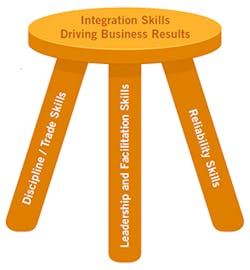How to build an in-house reliability team
Regardless of industry, reliability improvement teams appear to have a common set of goals assigned to them: improve safety, improve availability/reliability, and improve competitive costs. Basically, the plant will have a stronger market position if people go home safely every day, the equipment is not breaking as often, and we drive lower life cycle costs, which improves the economic outlook. As my colleague Paul Barringer would say: “You can’t repair your way to happiness.” This serves as a reminder to eliminate root causes of failures, instead of trying to repair faster than things breaking.
These goals are directly tied to the plant’s success in navigating current and future challenges. While we may not be able to answer these questions directly, an appropriate framework or mental model can help us understand the context and capabilities of the team to address the questions. I would like to introduce a conceptual framework regarding team member development based on several decades of observations.
To help us understand the environment within a reliability improvement team contributes to the success of a business, I propose that we utilize a mental model that I call the “Three-Legged Stool.” This model simplifies the complexity of the plant and provides a flexible framework, which can be used regardless of the team’s size, skills, competencies, expertise, and organizational structures based on the types, size, and location of plants. By using a mental model, we can compare, contrast, expand, summarize, and evaluate our experiences in a structured approach while also identifying potential blind-spots that could be problematic with the framework itself.
The stool consists of three core competencies (the stool legs) and the integration (the stool seat), which is about driving business results. While strong performance in any individual legs will improve the business results, the full benefit can only be achieved when the legs are integrated together to drive a laser-like focus on delivering business results. Often times, the big sexy equipment like compressors get all of the attention and effort. (Honestly, every technician, inspector, and engineer that I know are always excited to open up a broken compressor to see what surprises are on the inside.) In contrast, we can leverage the business results and accounting as a guide to our reliability improvement activities. By re-focusing our efforts on hidden gems (such as control system power supplies, circuit breakers, chemical injection pumps, alarm set-points, or other overlooked items), we may have an opportunity to have disproportionate impact on the economic and business performance of the plant. Basically, the legs alone do not make a stool. We need a seat to provide structure and integration such that we fully utilize the three core competencies. Later in the article, we will return to the seat, but let’s first explore the legs.
Discipline/trade skills
The first leg is about technical skills, or as I call them discipline skills. Furthermore, the emphasis extends to the contextual environment of the disciplines within specific plant. For this leg of the stool, a high level of skill and mastery for at least one technical competency is a good starting point for the reliability improvement team members.
So, what is meant by discipline and trade skills? Imagine someone is an electrical engineer, then their discipline would be electrical engineering. Similarly for an electrician, the discipline is that of the electrical trades. For any given industry, we usually have a multitude of disciplines required to successfully run and maintain the plant: pipefitters, electricians, boilermakers, millwrights, machinists, inspectors, technicians, engineers (mechanical, electrical, chemical, control systems, etc.), multi-skilled technicians, and many other technical/trade professionals in the plant. This team of professionals is one of the reasons why I love refineries and other manufacturing plants; they are essentially a “team sport.” It requires a team of dedicated professionals and no single person can fully understand the complexity of the plant. Even if someone had 20 technical PhDs and 20 years of experience in a craft-line, that person would still not fully understand how the plant works. We need a diverse team with breadth and depth that understand the plant.
The other aspect is the use of that skill set within the context of plant. I have observed talented engineers move from one industry to another, only to struggle for several years while they develop an understanding of the context of the plant. What is important in a pharmaceutical facility for a mechanical engineer may be different when compared to a phenol plant or a chip fabrication plant. A strong discipline skill combined with a deep contextual understanding of the plant provides a strong foundation. With the combination of discipline skill and plant context, these professionals can expand their understanding of how all of the functions work together. Essentially, all of the “hidden moving parts” of the organization (for example, maintenance, warehouse, logistics, repair shops, finance, scheduling, and safety) become understood in how they collectively deliver results.
Leadership and facilitation skills
The second leg of the stool is about leadership and facilitation skills of the reliability improvement team’s members. To solve many of the root causes within any plant, the team usually has to influence the broader organization and have to work through other people to make changes. These people usually report to different managers, have different perspectives, and may not have the same visibility of what can create problems and failures.
To increase the effectiveness of the reliability improvement team and to be more successful influencing the organization, the team should consider development in the following areas:
- an ability to communicate at all levels of the organization
- strong verbal and written communication skills
- influencing skills
- trust building and rapport building skills
- facilitation skills for leading small meetings and small teams
- coaching methods and skill
- presentation skills
- role modeling values and behaviors.
If your team already has strength in these initial areas, I suggest consideration be given to the following less common leadership skill areas:
- A3 Problem Solving
- SIPOC (Supplier – Input – Process – Output – Customer)
- basic GANTT charting
- High Reliability Organization (HRO)
- mental flexibility/cognitive flexibility
- mind mapping and association diagrams
- lateral thinking (as described by Edward de Bono)
- Neuro-Linguistic Programming (NLP)
- storytelling
- narrative based planning.
While some of these leadership skills may seem unconventional and even radical, since they are not directly associated with equipment and equipment failures, I posit that a plant’s reliability journey will have magnitudes more success when we get everyone on the bus as compared to just the reliability improvement team. Some of these skills are quite useful in helping our team members influence and engage the broader organization.
Reliability skills
The third leg of the stool is about our proficiency, capacity, and utilization of reliability skills and tools. To identify and understand the root causes of problems within any plant, there is a broad array of tools and methodologies utilized by reliability improvement teams.
Next steps forward: New skills and careers for veterans
Proactive leadership: Crisis-ready organizations need strong foundations
3 tips to improve your leadership skills
From my observation of the industry, strong discipline/trade skills and leadership skills are the most abundant stool legs. Conversely, strong reliability skills are the least frequent stool leg and are harder to acquire. I have observed many instances where a company had a limited number of strong reliability practitioners and the marketplace was unable to provide these resources either. These plants had to essentially “grow their own” reliability practitioners by recruiting strong discipline performers with demonstrated leadership capability and training them in the reliability skills and tools. As suggested in Terry Alexander’s article “6 attributes to look for when you hire your next reliability engineer,” (https://plnt.sv/1803-RE), I agree that plants should consider formal certifications and educational backgrounds while growing reliability skills. By using an existing external framework, the team can more quickly identify and acquire these skills.
While we will likely have to “grow our own” set of skills, it is critically important to identify which skill sets to develop. Given the challenges and opportunities that face your plant, determining which skills will have the most impact is vital. I believe a good starting point for is developing the following skills: Root Cause Analysis, the associated 5-Why Analysis, and Cause Trees. For my reliability teams, I ensured that we had trained and competent root cause analysis practitioners as our corner stone. After the developing the root cause skills, we pursued and developed other reliability skills.
Here is a starting list to consider, in no given order, for your reliability improvement team’s set of the skills, methodologies, and tools:
- Risk Analysis
- Basic Statistical Analysis
- Data Analysis
- Boston Squares
- Problem Structuring Methods/ Problem Framing
- Kepner-Tregoe
- Decision Analysis
- Pareto Charts
- Growth Charts
- Ishikawa Diagrams
- FMEA/FMECA
- Fault Tree Analysis (FTA)
- Event Tree Analysis (ETA)
- Weibull Analysis
- Reliability Block Diagrams (RBD) and Modeling
- Flow Charting
- Sparing Studies
- Maintainability Studies
- Statistical Process Control and Control Charting
- Reliability Centered Maintenance (RCM)
- Systems Engineering and System Thinking
- Requirements Engineering
- Work Process Management
- PM/CM Planning and Development
- Thermography
- Total Productive Maintenance (TPM)
- Metric and KPI Development and Monitoring
- Visualization
- Human Factors
- Operations Research (OR)
- Predictive Methodologies
- Many more tools and methods.
The key is not necessarily to learn all of these skills, but identify which tools should go into the team’s toolbox, and then systematically apply the tools to the problems. I have been amazed on the keen insights that can be uncovered by utilizing a simple Boston Square or a Pareto Chart. While the tools listed above are not complete, I suggest choosing tools that allow reliability improvement teams to see what is occurring, to quantify the prize, and systematically address the challenges.
Integration skills – driving business results
The seat of the stool is about integrating the three legs of the stool to drive meaningful business results. While each of the legs is fundamental and necessary, alone they are not sufficient to unlock the value potential. This value is sometimes called “Gap to Potential,” where we compare our current performance to the potential performance of the best in industry. One approach is to leverage benchmarking of equipment, processes, and plants.
Another approach is a systematic bottoms-up methodology looking for value throughout the plant, using the financial and production information to link to the reliability performance. For example, if you know that a 1% loss in plant availability was worth $1,000,000 annually, then we may be able to link the production loss tracking to the financial opportunities to understand how big the carrot may be.
As an example, let’s assume that the 0.5% of production availability was lost to a group of amine centrifugal pumps. By framing up the problem in an integrated manner, you can quantify that you could improve the plant’s performance by $500,000 a year to justify a planned set of improvement activities.
These activities could be benchmarking amine pump performance with other plants to identify deltas in MTBF that could be investigated. Another activity could be benchmarking aspects of the MTTR to understand if the opportunity lies with improvement in repair shop performance, spare parts availability, complete warehouse spare pumps, or possibly installed spare pumps. It is possible that the equipment does not need to be changed and the opportunity resides with how the equipment is run and the associated operator alarms. When found, these opportunities have an incredible return on investment since they require influencing different teams to change behavior and capital expenditures are not required.
The key is leveraging the three legs and integrating the activities using a risk-based economic manner to identify what to go after first, second, and so on down a prioritized opportunity list. While we still have to do the hard work, we can often present a strong business case to senior management who will support the initiative when we use a language that they understand.
Using the three-legged stool
By adopting various mental models, we can frame-up the decisions needed to improve and support the reliability improvement teams within our plants. We can look at the skill set of the team and the team members, the challenges and opportunities that each individual plant faces, and then tailor our plan to work through the team to improve the outcomes. This mental model can help reliability improvement teams, regardless of industry, pursue common goals assigned to them and deliver outcomes: improved safety, improved availability/reliability, and improved competitive costs.
By having a model for the competencies of the reliability improvement team, we can begin to address the question of how to improve and build the team. Also, we increase the team’s relevance since they are delivering meaningful results to the business when utilizing the model. Lastly, we can use the model to look into a metaphorical mirror to better understand what is required to stay competitive in a changing market. So, with one closing thought for you to consider: What does your Three-Legged Stool look like?
This story originally appeared in the November 2021 issue of Plant Services. Subscribe to Plant Services here.
Brian Y. Webster, CRE is a Senior Operations Readiness Engineer - MRTA (Maintenance, Reliability, Turnaround) currently delivering assets from several billion dollars of capital projects for a global integrated energy company. In a previous role, he was the Reliability Manager for a first quartile reliability refinery in the Pacific Northwest of the United States. He has 28 years of engineering and maintenance experience in the oil and gas Industry and also served as an Ordnance Officer in the U.S. Army.


